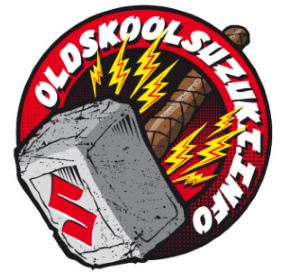-
Posts
5,755 -
Joined
-
Last visited
Content Type
Profiles
Forums
Events
Everything posted by Gixer1460
-
And its a Hippo - fast isn't in its nature LOL!
-
A m8 with a mag4, similar problem - ended up cutting the offending tube out and remaking it with space!
-
Hasn't been around for well over a year so you may never get a response! Reading through the whole thread I would have said piston slap - I had a 1186 kit that slapped more than I liked after just 6000 miles so its not an impossible diagnosis!
-
They are bike specific but you'd really be pushed to notice any difference they make in real world conditions!
-
Just look how the power climbs - little bit faster than the front wheel heading skywards!
-
Strange place for damage if it is damaged - looks like Isopon glass fibre resin!
-
Apologies for getting some of the colours wrong - i'm used to 1100's LOL!
-
There should never be voltage measured anywhere on the crank signal generator unless the engine is turning - it self generates millivolts level signal. From memory and never used a M-Unit (but I assume it has a dedicated Ign output?) goes like this . . . . . M-Unit Ign output (12v) goes to 750 ICM / ECU / CDI (whatever you want to call it) orange/white wire AND the coil low tension terminals + side. (its a switched live) M-Unit must have an earth to battery and chassis - Suzuki colour Black/white. The CDI also requires ground - Black/white. From CDI there are two output wires - White and a Black/Yellow, each goes to a coil - (I think White is 1/4 and B/Y is 2/3? . . . . 50% chance of being right LOL) From crank signal generator there are two wires - Blue and Yellow. These connect to CDI input side which should be Blue & Yellow!. There is one last wire from CDI - Red/Black - this is the tacho signal and runs to the rev counter input. Connected as above - you should have sparks and engine will run (with other variables supplied & coils - connected right way round LOL)
-
I have no particular preference as if I have a two outlet tap and only one line to carbs, I just block the spare or convert carbs to have two separate feeds. If you are handy with tools, a tank adapter block and an in-line, ball valve tap could save a chunk of money?
-
I understood a pitot opening should face into the airflow, so if the air is entering the tube from the left in 1st pic this would give the best signal - square or slash cut end makes little difference. The 2nd one marginally worse but slash cut into airflow can't be achieved, a bend would help. 3rd and 4th I think will suck air (vacuum) rather than get pressurised - similar to a jet in a venturi . Positioned in centre of the up-tube gets straightest / fastest / less turbulent air which is good but it could be at the edge but with slightly slower air due to friction / turbulence. BTW pitot's on planes used to read airspeed, usually face forward.
-
Dual pods - yes, Individual pods - no! And with stock carbs - usually a DJ kit (or others are available but i've not used them) works mint! Don't ask me why, its just fact. Many have tried 4 singles with varying results usually unsatisfactory!
-
A picture of a mythical object LOL! If my counting teeth is about right, I get 39 / 27 ratio ? against a 750 ratio of 38 / 29. If so, the oil pump should spin about 10% faster? Will it make 10% more pressure ? 10% more of knob all is still knob all LOL!
-
Not quite true - cams are all plain bearings and are furthest away from pump plus those running turbo's which have plain bearings need approx 25-30psi minimum for any sort of life! We've all seen cam bearings wiped out through low / no oil! Its one of the reasons drag racers used to block off oil feed to gearbox, just to get that little bit more to the engine - gearbox happy with splash lubrication.
-
Looks like a 'Highpower' kit - I think they are still trading, Doncaster way I believe? . . . . . https://noswizard.com/contacts
-
Really, the 'prime' position isn't meant for running the engine although people do - its purpose / action is, to lift the diaphragm marginally to fill the float bowls on empty carbs - after a rebuild or after running out of fuel. The gap isn't designed for long term, full power fuel flow! Adding a fuel pump would mask a problem, not improve it as the pump will try to draw more fuel than the tap can deliver in 'prime' position. A Pingle tap (for instance) has a single in-tank delivery pipe with a 6mm bore - doesn't make any difference if tap has 1, 2 or 3 outlets - it has one 6mm bore pipe from tank . . . . and that is enough for over 350+ turbo EFI hp ! The float valves in the carbs, at the needle valve, have a 1.5mm ? opening which across 4 carbs = 28.26 sq mm (approx) and a Pingle has a pipe bore area of 113.04 sq mm. Your 10mm tank outlet has an area of 314 sq mm. So, the tank outlet is 11 times larger than the carbs can utilise, but its size reduces the potential flow restriction and increasing the pressure seen at the float jets - its a miniscule increase but maybe enough to tip over the edge?
-
Web cams are likely ground on fresh cast billets, Kents more than likely regrinds on old cams would explain cost difference. I'm guessing the specs are noting different things as you suspect - Web = installed valve lift, Kent = measured lobe ht. from base circle ?
-
If the top end is off then sploshing diesel over crank and around the cases with either drain plug out or (for more mess) with sump pan off - will get it squeeky clean and won't hurt anything - all obviously AFTER you've dropped the oil and filter!
-
Seems to spin over waaaaay to fast to me? If the float was upside down you'd never have got the cover back on ! ! ! A leak down test would be more diagnostic to check valves and piston rings and general wear in the top end. Have the valve been gaped correctly? Is it on points? If so, are they gapped correctly? Leaking carbs is never good especially after a rebuild !
-
I'd like to see some of these 'mythical' higher ratio gears? Its just that for the 40 odd years that drag racers have been abusing these engines with just about every modification anyone could think of, no one nor none of the specialist aftermarket vendors bothered with having hi ratio gears made . . . . . Even Chris Hannam, owner of Cannon Engineering, who were gear cutters to industry and beyond, never considered making them and cornering the global market!
-
Too many variables to give accurate answer - diameter of twist grip cable barrel, length of throttle arm or throttle cable barrel - all will give different pull lengths!
-
^ ^ ^ ain't no good with a turbo / forced induction though! The one used is correct and designed for blown applications!
-
You can pass 500cfm through a 100mm pipe or a 50mm pipe - the only difference is initial pressure and what the end pressure is in the plenum
-
I've never needed to bend a frame mounting to fit an engine to anything - unless they are bespoke mounts to take a different engine, there is generally wiggle / spacer room between cases and frame mounts! With all of the 'dubious' history your frame seems to have, i'd suggest it didn't originally come with an engine that physically big!
-
As Arttu says it really is a minimal difference - 0.1bar / 1.5psi at max airflow (in his 12k example). I use 50mm (nominal) up pipe and have a IC that I understand has an approx pressure drop across the core of about 1-2psi, so for me, the saving of maybe 0.5psi using a bigger pipe is insignificant in the grand scheme of things. I'd actually prefer a 20 - 30 deg greater temp drop across the intercooler but that would induce a greater pressure drop . . . . . . nothing come free!



